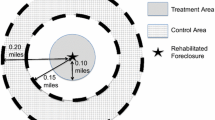Abstract
Over the past 3 years, increased rates of mortgage foreclosures in the U.S. have resulted in widespread bankruptcies of financial institutions and massive losses of consumer wealth. The effects have been especially pronounced in economically vulnerable regions. In response, municipalities and community-based organizations provide a variety of services to mitigate the effects of foreclosures. Purchases of foreclosed properties represent a particularly attractive strategy because they have the potential to minimize blight, reduce unanticipated housing mobility, and to provide affordable homeownership opportunities. Since the cost of such purchases far exceeds the resources available in most urban centers, not-for-profit managers must solve the following decision problem: What subset of a large number of available foreclosed properties should be acquired for neighborhood stabilization and revitalization? In this paper, we present an extension of the multi-objective nonlinear knapsack problem to generate alternative portfolios of foreclosed multifamily rental properties to jointly optimize social benefits, social costs and equity. We apply our model to the Massachusetts city of Lowell, which has faced sharp increases in foreclosures since 2006. A subset of available Pareto-optimal solutions displays policy-relevant variation in decision space and objective space. We identify a promising compromise solution that places greatest emphasis on the goal of maximizing proximity of acquired units, and compare model results with strategies derived from heuristics inspired by real-life applications.







Similar content being viewed by others
Notes
Tract-level data for Lowell are available only for the 2000 Census, not the more recent American Community Survey.
References
Abandoned Houses Work Group (2005) Revitalizing Indianapolis neighborhoods: a framework for linking abandoned houses and redevelopment initiatives, A Second Report of the Abandoned Houses Work Group. City of Indianapolis, January 2005. World Wide Web: http://www.indy.gov/eGov/City/DMD/Planning/Docs/Housing/abandonedhousingreport0105.pdf. Accessed January 23, 2010
Altschuler A, Somkin CP, Adler NE (2004) Local services and amenities, neighborhood social capital, and health. Soc Sci Med 59(6):1219–1229
Bartik TJ, Smith VK (1987) Urban amenities and public policy. In: Mills ES (ed) Handbook of regional and urban economics, volume II: urban economics. North-Holland, Amsterdam, pp 1207–1249
Bartik TJ, Butler JS, Liu JT (1992) Maximum score estimates of the determinants of residential mobility: implications for the value of residential attachment and neighborhood amenities. J Urban Econ 32(2):233–256
Bazgan C, Hugot H, Vanderpooten D (2009) Solving efficiently the 0–1 multi-objective knapsack problem. Comput Oper Res 36:260–279
Beausoleil RP, Baldoquin G, Montejo RA (2008) Multi-start and path relinking methods to deal with multiobjective knapsack problems. Ann Oper Res 157:105–133
Bernanke BS (2008) Housing, mortgage markets, and foreclosures. Speech at the Federal Reserve System Conference on Housing and Mortgage Markets, Washington, D.C., December 4, 2008. World Wide Web: http://www.federalreserve.gov/newsevents/speech/bernanke20081204a.htm. Accessed January 23, 2010
Buotte BJ (2008) Lending a hand in loan crunch. Boston Globe, February 7, 2008
Carr JH (2007) Responding to the foreclosure crisis. Hous Policy Debate 18(4):837–840
Citizens’ Housing and Planning Association (2009) Housing foreclosure dataset for selected municipalities in the Boston metropolitan area provided to Center for Social Policy, University of Massachusetts Boston and summarized by authors
Cohen JR (2000) Abandoned housing: exploring lessons from Baltimore. Hous Policy Debate 12(3):415–448
Cohon JL (1978) Multiobjective programming and planning. Academic, New York
Ehrgott M, Gandibleux X (2002) Multiobjective combinatorial optimization—theory, methodology and applications. In: Ehrgott M, Gandibleu X (eds) Multiple criteria optimization: state of the art annotated bibliographic surveys. Kluwer Academic Publishers, New York, pp 369–444
Eiselt HA, Sandblom C-L (2004) Decision analysis, location models and scheduling problems. Springer, Berlin
Erlenkotter D (1977) Facility location with price-sensitive demands: private, public, and quasi-public. Manage Sci 24(4):378–386
Federal Reserve Bank of Boston (2010) Foreclosure Rates in Massachusetts Cities and Towns: 1990–2009. World Wide Web: http://www.bos.frb.org/economic/dynamicdata/module1/bmap.html#app=1dc8&2888-selectedIndex=0. Accessed February 6, 2010
First American CoreLogic (2009) Summary of Second Quarter 2009 negative equity data from first American CoreLogic. August 13, 2009. World Wide Web: http://www.loanperformance.com/infocenter/library/FACL%20Negative%20Equity_final_081309.pdf . Accessed January 22, 2010
Fotheringham AS, O’Kelly ME (1989) Spatial interaction models: formulations and applications. Kluwer Academic Publishers, Dordrecht
Gabriel SA, Faria JA, Moglen GE (2006) A multiobjective optimization approach to smart growth in land development. Socio-Econ Plann Sci 40:212–248
Galster G, Tatian P, Accordino J (2006) Targeting investments for neighborhood revitalization. J Am Plann Assoc 72(4):457–474
Gihose R (2003) Community participation, spatial knowledge production, and GIS use in inner-city revitalization. J Urban Technol 10(1):39–60
Gilbert KC, Holmes DD, Rosenthal RE (1985) A multiobjective discrete optimization model for land allocation. Manage Sci 31(12):1509–1522
Glickman NJ, Servon LJ (1998) More than bricks and sticks: five components of community development corporation capacity. Hous Policy Debate 9(3):497–539
Harding JP, Rosenblatt E, Yao VW (2009) The contagion effect of foreclosed properties. J Urban Econ 66(3):164–178
Herbert CE, Belsky ES (2008) Initial housing choices made by low-income and minority homebuyers. Cityscape 10(2):61–94
Higle JL (2005) Stochastic programming: optimization when uncertainty matters. In: Cole Smith J (ed) Tutorials in operations research 2005: emerging theory, methods and applications. Institute for Operations Research and the Management Sciences, Hanover, pp 30–53
Howe RP (2010) Trends in real estate in 2009. Merrimack Valley Housing Report 3(1):2
Hulse K, Burke T (2000) Social exclusion and the private rental sector: the experiences of three market liberal countries. Paper presented at the ENHR 2000 conference, Gävle June 26–30, 2000
ILOG-CPLEX Division (2005a) AMPL 8.0. Incline Village, NV
ILOG-CPLEX Division (2005b) CPLEX 8.0 for AMPL. Incline Village, NV
Immergluck D (2009) The foreclosure crisis, foreclosed properties, and federal policy: some implications for housing and community development planning. J Am Plann Assoc 75(4):406–423
Ioannides YM, Zabel JE (2008) Interactions, neighborhood selection and housing demand. J Urban Econ 63(1):229–252
Isada Y, James RJW, Nakagawa Y (2005) An approach for solving nonlinear multi-objective separable discrete optimization problem with one constraint. Eur J Oper Res 162:503–513
Johnson MP (2007) Planning models for affordable housing development. Environ Plann B Plann Des 34(3):501–523
Johnson MP (2010) Housing and community development. In: Cochran J (ed) Wiley Encyclopedia of Operations Research and Management Science, to appear
Johnson MP, Hurter AP (1999) Economic impacts of subsidized housing relocation. Pap Reg Sci 78(3):265–295
Johnson MP, Turcotte D, Sullivan FM (2009) Joseph P. Healey Grant Program, “Decision Modeling for Foreclosed Housing Acquisition in a Large Urban Area,” July 2009–July 2010. Funded at $6,000
Joint Center for Housing Studies of Harvard University (2009) The State of the Nation’s Housing 2009. Cambridge, MA. World Wide Web: http://www.jchs.harvard.edu/publications/markets/son2009/son2009.pdf. Accessed January 16, 2010
Kingsley GT, Smith R, Price D (2009) The impacts of foreclosures on families and communities. The Urban Institute, Washington. World Wide Web: www.urban.org/UploadedPDF/411909_impact_of_forclosures.pdf. Accessed January 16, 2010
Klamroth K, Wiecek MM (2000) Dynamic programming approaches to the multiple criteria knapsack problem. Nav Res Logist 47:57–76
Klinger M, Susong M (1996) The construction project: phases, people, terms, paperwork, processes. American Bar Association, Chicago
Kuby M (1987) Programming models for facility dispersion: the p-dispersion and maxisum dispersion problems. Geogr Anal 19:315–319
Leitner H, Ellwood S, Sheppard E, McMaster S, McMaster R (2000) Modes of GIS Provision and their appropriateness for neighborhood organizations: examples from Minneapolis and St. Paul, Minnesota. URISA J 12(4):45–58
Leonard T, Murdoch J (2009) The neighborhood effects of foreclosure. J Geogr Syst 11(4):317–332
Malach A (2008) Managing neighborhood change: a framework for sustainable and equitable revitalization. National Housing Institute, Montclair. World Wide Web: http://www.nhi.org/pdf/ManagingNeighborhoodChange.pdf. Accessed January 16, 2010
Malach A (2009) Stabilizing communities: a federal response to the secondary impacts of the foreclosure crisis. The Brookings Institution, Washington. World Wide Web: http://www.brookings.edu/∼/media/Files/rc/reports/2009/02_foreclosure_crisis_mallach/02_foreclosure_crisis_mallach_report.pdf. Accessed January 16, 2010
Marsh MT, Schilling DA (1994) Equity measurement in facility location analysis: a review and framework. Eur J Oper Res 74:1–17
Martello S, Toth P (1990) Knapsack problems: algorithms and computer implementations. Wiley, Chichester
McLeod H, Crutchfield LR (2007) Creating high-impact nonprofits. Stanford Social Innovation Review. Fall 2007. World Wide Web: http://www.ssireview.org/articles/entry/creating_high_impact_nonprofits/. Accessed March 21, 2010
Mortgage Bankers Association (2009) Delinquencies and foreclosures continue to climb in latest MBA National Delinquency Survey. World Wide Web: http://www.mbaa.org/NewsandMedia/PressCenter/69031.htm. Accessed January 15, 2010
Puterman ML (2005) Markov decision processes: discrete stochastic dynamic programming. Wiley, Hoboken
RealtyTrac.com (2010) RealtyTrac® Year-End Report Shows Record 2.8 Million U.S. Properties With Foreclosure Filings In 2009. World Wide Web: http://www.realtytrac.com/contentmanagement/pressrelease.aspx?itemid=8333. Accessed February 10, 2010
ReVelle C (1987) Urban public facility location. In: Mills ES (ed) Handbook of regional and urban economics, vol II. North-Holland, Amsterdam, pp 703–714
Rosen HS (2004) Public finance, 7th edn. McGraw-Hill Irwin, Boston
Rui Figueira J, Tavares G, Wiecek MM (2010) Labeling algorithms for multiple objective integer knapsack problems. Comput Oper Res 37:700–711
Sampson RJ, Raudenbush SW, Earls F (1997) Neighborhoods and violent crime: a multilevel study of collective efficacy. Science 277(5328):918–924
Sanchez TW, Dawkins CJ (2001) Distinguishing city and suburban movers: evidence from the American housing survey. Hous Policy Debate 12(3):607–631
Schuetz J, Been V, Ellen IG (2008) Neighborhood effects of concentrated mortgage foreclosures. J Hous Econ 17(4):306–319
Simmons R, Salling M (1995) Using GIS to make Parcel-based real estate decisions for local government: a financial and environmental analysis of residential lot redevelopment in a Cleveland neighborhood. URISA J 7(1):7–19
Taylor J (2008) Help now, not later. Shelterforce, Spring 2008: 16–18. World Wide Web: http://www.shelterforce.org/article/211/help_now_not_later. Accessed January 23, 2010
The Boston Foundation (2008) Passion & purpose: raising the fiscal fitness bar for Massachusetts nonprofits. Prepared by Elizabeth Keating, Geeta Pradhan, Gregory H. Wassall and Douglas DeNatale. Web: http://www.tbf.org/UtilityNavigation/MultimediaLibrary/ReportsDetail.aspx?id=8014. Accessed March 21, 2010
The Enterprise Foundation (1999) Creating multifamily rental housing through renovation. Prepared by Bob Santucci, Bill Batko, Carter Cosgrove + Company, Ben Hecht, Scott Hoekman, Catherine Hyde, Matt Perrenod, Jane Usero and Benjamin Warnke. Columbia, Maryland. World Wide Web: http://www.practitionerresources.org/cache/documents/36613.pdf. Accessed January 23, 2010
The Warren Group (2009) Massachusetts Foreclosures Soar 62% in 2008. Press Release, January 21. World Wide Web: http://www.thewarrengroup.com/portal/Solutions/PressReleases/tabid/190/newsid751/2206/Default.aspx. Accessed February 10, 2010
The Warren Group (2010) More Bay State Homeowners Face Foreclosure in 2009, but fewer lose their homes. Press Release, January 21.World Wide Web: http://www.thewarrengroup.com/portal/Solutions/PressReleases/tabid/190/newsid751/2377/Default.aspx. Accessed February 10, 2010
Thrall GI (1998) GIS applications in real estate and related industries. J Hous Res 9(1):33–59
U.S. Census Bureau (2009) American FactFinder: American Community Survey: World Wide Web: http://factfinder.census.gov/servlet/DatasetMainPageServlet?_program=ACS&_submenuId=&_lang=en&_ts=. Accessed February 6, 2010
U.S. Department of Housing and Urban Development (HUD) (1998) Analysis of total development costs in public housing. Prepared by Christopher Logan, Hin-Kin Lam, Seth Cooper and James Wallace, Abt Associates. Washington, D.C. World Wide Web: www.abtassociates.com/reports/ES-D19980856.pdf. Accessed January 26, 2010
U.S. Department of Housing and Urban Development (HUD) (2008) Preston allocates nearly $4 billion to stabilize neighborhoods in states and local communities hard-hit by foreclosure. September 26, 2008. World Wide Web: http://www.hud.gov/news/release.cfm?content=pr08-148.cfm. Accessed January 23, 2010
U.S. Department of Housing and Urban Development (HUD) (2009) HUD Implementation of the Recovery Act. World Wide Web: http://portal.hud.gov/portal/page/portal/RECOVERY/about. Accessed January 23, 2010
Visée M, Teghem J, Pirlot M, Ulungu EL (1998) Two-phases method and branch and bound procedures to solve the bi-objective knapsack problem. J Glob Optim 12(2):139–155
Wright J, ReVelle C, Cohon J (1983) A multiobjective integer programming model for the land acquisition problem. Reg Sci Urban Econ 13:31–53
Zeng TQ, Zhou Q (2001) Optimal decision making using GIS: a prototype of a Real Estate Graphical Information System (REGIS). Int J Geogr Inf Sci 15(4):207–321
Acknowledgements
Thanks to Rachel Drew for her research assistance. Thanks to Steven Winter, Metropolitan Area Planning Council; Richard Howe, Jr., Registrar of Deeds, Middlesex North Registry of Deeds; John Fraser, Graduate Student, Regional Economic and Social Development, UMass Lowell; Joe Donovan, GIS Manager, City of Lowell; Miran Fernandez, CIO, City of Lowell; John Matley, GIS Coordinator, Northern Middlesex Council of Governments; Alex Brown, GIS Lab, UMass Lowell Environmental, Earth and Atmospheric Sciences; Adam Baacke, Assistant City Manager/DPD Director, City of Lowell, and Matthew Roux, Assistant Transportation Planner, City of Lowell.
We greatly appreciate the comments and suggestions of anonymous reviewers and the editor.
Author information
Authors and Affiliations
Corresponding author
Rights and permissions
About this article
Cite this article
Johnson, M.P., Turcotte, D.A. & Sullivan, F.M. What Foreclosed Homes Should a Municipality Purchase to Stabilize Vulnerable Neighborhoods?. Netw Spat Econ 10, 363–388 (2010). https://doi.org/10.1007/s11067-010-9138-3
Published:
Issue Date:
DOI: https://doi.org/10.1007/s11067-010-9138-3




